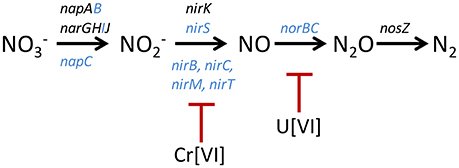

EmrAB operon was another well-studied MDR pump in Escherichia coli (Lomovskaya and Lewis 1992), and was also reported in Aquifex aeolicus, Rhodobacter capsulatus, Salmonella typhimurium etc.

2002), and DsbA-DsbB system in Burkholderia cepacia was involved in metal-efflux and multi-drug resistance (Hayashi et al. The MexGHI-OpmD efflux pump in Pseudomonas aeruginosa could improve the bacterial resistance to vanadium and ticarcillin (Aendekerk et al. 2000), the copper and macrolide resistance plasmid ( tcrB- ermB) was found in Enterococcus faecium (Aarestrup et al. Plasmids from Salmonella abortus equi contained resistances to ampicillin and several metals (Ghosh et al. Beside the gene linkage phenomenon of metal and antibiotic resistance on transferable elements which was found several decades ago, multidrug resistance (MDR) pump was another important mechanism explored afterwards (Foster 1983). Compared with the above massive studies in community level, less research focused on the molecular bases of co-resistance or the mechanisms where co-resistance came from. 2012), and other polluted water environments (Baker-Austin et al. 2010), livestock farms contaminated by animal feeding amendment (Hölzel et al. Metal-induced co-resistant bacteria was frequently found in various metal contaminated environments, including shores polluted by hospital wastes and factory discharges (Matyar et al. Therefore, it is essential to fully understand the co-resistant mechanism of metals and antibiotics, and find ways to decelerate the spreading tendency of resistant genes. The metal contamination is hard to eliminate due to the huge areas and scattered distributions, metal-induced antibiotic resistance are enriched either in amount or abundance under metal stress, and incurable diseases caused by resistant pathogens would be prevalent and become a disaster (Aminov 2010). Metal-induced antibiotic resistance is supposed to be more prevalent than antibiotic itself, due to the fact that metals were more persistent than antibiotics in nature environment (Kolpin et al. Meanwhile, many studies have found that antibiotic resistance positively correlated to toxic metals or other antimicrobials in environments (Seiler and Berendonk 2012). Abuse of antibiotics was used to be supposed as the major cause but the decreased usage of antibiotics subsequently does not necessarily prevent the spread of antibiotic resistance in clinical (Salyers and Amábile-Cuevas 1997). 2002 Chambers and DeLeo 2009 Poirel et al.
#Han 2010 pbp3 pseudomonas series#
But since the occurrence of vast antibiotic resistant pathogens in 1960s, a series of superbugs were found to have pan-drug resistance, like MRSA (Methicillin-resistant Staphylococcus aureus), NDM-1, vancomycin-resistant enterococci (VRE) and CA-MASA (Enright et al. Our results demonstrated that the chromosomal emrAB operon in Staphylococcus aureus LZ-01 was a new type of multidrug resistance system, which conferred both ampicillin and chromate resistance to host cells inhabiting polluted environments.Īntibiotics were once the most powerful weapon against diverse diseases in human medical history since its discovery in early 20th century. The induction effect could be eliminated by deletion of emrA or emrB. The presence of 0.50 mM Cr(VI) induced an elevation in ampicillin resistance from 0.50 to 2.50 mg/ml in the strain LZ-01, similarly, its Cr(VI) resistance was also found to be elevated from 6 to 10 mM by 0.15 mg/ml ampicillin induction. The complemented strains of both deletion mutants basically restored their resistant performance. Mutant strain with emrA gene knockout resulted in a 0.83-folds decrease in chromate resistance, and a 0.80-folds decrease in ampicillin resistance while emrB knockout strain resulted in a 0.33-folds decrease in chromate resistance, and a 0.60-folds decrease in ampicillin resistance.

Quantitative PCR results revealed that this operon was upregulated (1.60-folds for emrA, 2.34-folds for emrB) after 0.20 mg/ml ampicillin treatment. Transcriptome data showed that an emrAB operon was upregulated (1.29-folds for emrA, 2.14-folds for emrB) under 0.4 mM Cr(VI) treatment. Strain Staphylococcus aureus LZ-01 which was isolated from industrial wastewater discharging site can co-resist to 6 mM Cr(VI) and 0.75 mg/ml ampicillin. EmrAB operon is known for multidrug resistance in bacteria and yet has not been reported related to heavy metal resistance or antibiotics/heavy metal co-resistance.


 0 kommentar(er)
0 kommentar(er)
